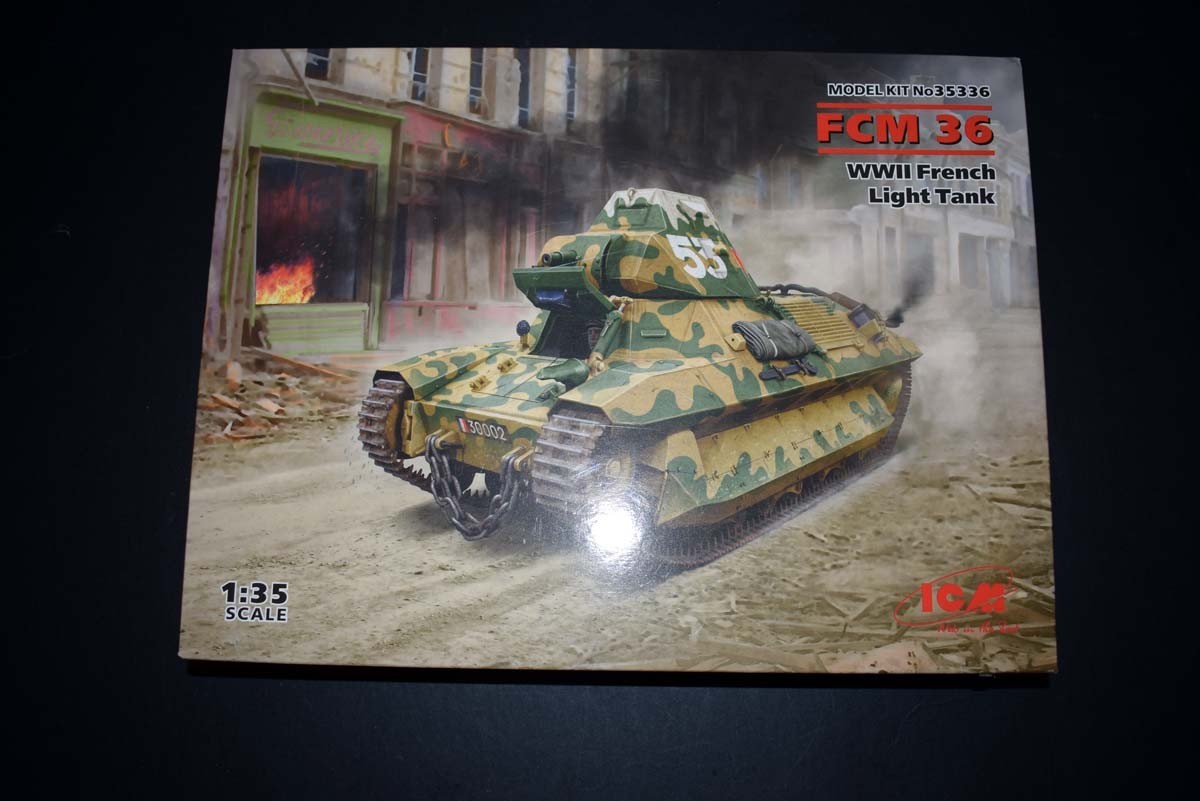
Introduction
The following introduction is as provided by ICM:
The FCM36 or Char Leger modele 1936, FCM is a light infantry tank that was designed for the French Army prior to World War 2. It had a crew of 2, and was equipped with a short 37mm gun and a 7.5mm coaxial machine gun. Power was provided by a diesel engine. In 1938/39 100 FCM 36 tanks were delivered to the French Army. They took part in May/June 1940 French/German battles.
Review
This offering from ICM, is the first model of this vehicle from them. It is packed the usual high standard of a flip top cardboard tray, and then a additional card lid with the art work. In side the model is packed in a re-sealable plastic bag, with the decals packed inside the instruction booklet. As your are aware I am not a fan of all parts being packed inside one bag, due to the risks of damage. In the case of this model, one piece has come off the sprue, but does not appear to be obviously damaged. In all other respects the parts are provided as I would expect from ICM.
Hull
The FCM36 is a diminutive little tank, and so I was surprised to find the lower hull supplied in multiple parts. With that said, it has allowed ICM to provide some nice moulded on detail. My one concern is the sides of the lower hull, which if not cleaned up correctly, or carefully placed could be off set. However, if you follow the instructions the front and rear of the lower hull, where it is angled, should enable you to get the sides correctly placed and orientated. While on the subject of the underside of the hull, I am very pleased with the effort that ICM have put into the detail provided.
The upper hull is a straight forward addition to the kit with most of the detail moulded on. Except for some very small hinge attachments which will probably make the myopic among us swear!!! The louvered engine access panels, are provided separately, and add a nice touch. The drivers hatch, can be displayed open or closed, but with no interior present consideration will need to be given into how to fill the space. The last article of note is the exhaust which is a very visible part on this kit. My only disappointment here is that the vent on the exhaust has not been moulded open, despite having been moulded in two parts. A plus side to this being moulded in two halves does mean that the modeller does have easy access to open these aspects themselves.
Wheels and Tracks
All of the wheels and drives on this model, are fairly simple in their design. Other than the small size of the road wheels, I can see no issues with the attachment of these parts. The drive wheels itself, does have some very nice detail on it. My only reference on this tank, is via on-line images only and everything I have seen thus far appears to match on-line reference. However it does need to be remembered, that these are preserved vehicles and may not be 100% accurate. The only aspect that I do not like, are the vinyl rubber tracks even though they appear to be accurate, vinyl rubber has become a bit of a bug bear with me. I do however appreciate, the ICM has provided a close up of the track links in order that you can accurately orientate their direction.
Turret
The turret of this model is very small, and I would imagine not the most pleasant place to be in peacetime, let alone war. The machine and main gun, has been well tackled and provided full length (including the breech end). The machine gun will require its muzzle to be drilled for accuracy. Hatches are provided separately for the turret, and this includes handles, which is pleasing to see. This particular vehicle has a large chain stowed on both the front and rear of the model, and ICM has provided this as individual plastic links. My gut says; use these links to find a suitable chain, as I can see them being a pain to use in plastic.
Finishing Options
ICM has provided two finishing options for this model, which are:
FCM36, 7thBCC, Chemery, France, May 14th, 1940
FCM36, 4thBCC, France, June 10th , 1940
One of the things that can be said for French tanks, is that they have very visually appealing camouflages applied, and also colourful decals, in this case hearts. The two finishing options are very different in their appearance, and I personally find both options appeal to me. An examination of the decal sheet, shows decals that are nicely thin, and so should not present any issues when applied to the model.
Conclusion
The FCM36 is a little covered subject that is a great addition to ICM’s range. Looking at the model, everything appears as it should when compared to on-line reference. With the only critique I personally have being the vinyl rubber tracks. But this is what ICM always provides and they are reasonable for the material used.

